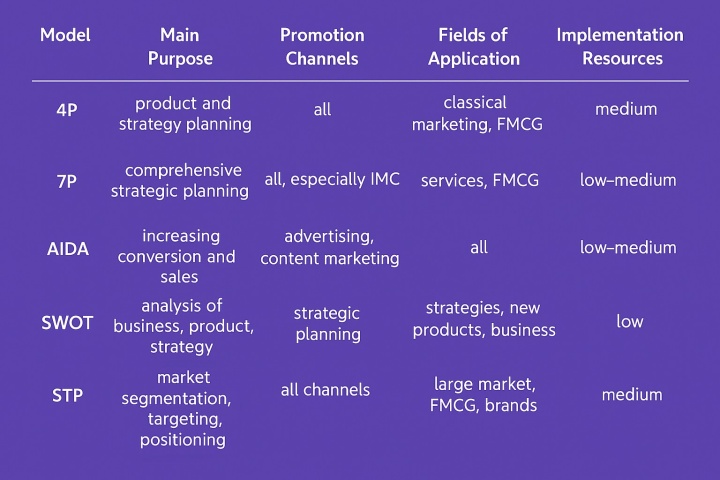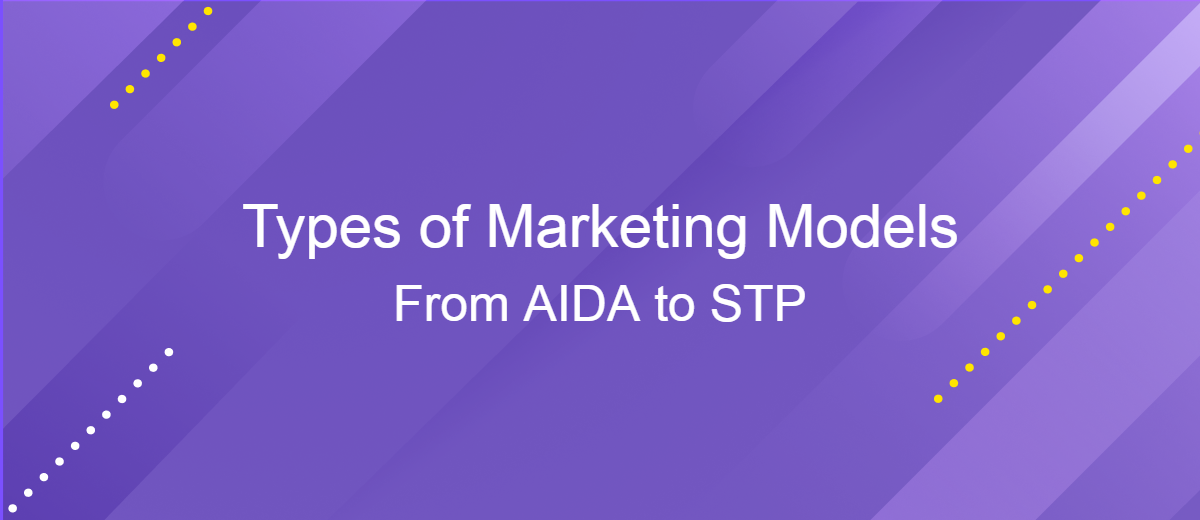Types of Marketing Models Explained – From AIDA to STP
One of the key tasks of business is to lead the client to the target action, or conversion. The effectiveness of most marketing strategies depends on it. To achieve this, marketers use proven models that help systematize work with the audience. In this article, we will consider the most popular of them. You will learn what the 4Ps of marketing are, the 7Ps marketing mix, the STP framework, as well as other concepts, their principles, and areas of application.
What Are Marketing Models
A marketing model is a set of actions and tactics that help companies optimize interactions with their target audience and thereby strengthen their market position. It is developed based on large-scale marketing research, including the study of consumer behavior, analysis of communication with the target audience, and other important aspects.
Most models consolidate a set of data with a schematic description of customer acquisition activities. As a rule, they contain information about what motivates consumers, what steps they take before buying, and how to stimulate the interest or loyalty of the audience.
Proper use of marketing models and frameworks allows a business to achieve a number of strategic goals:
- Increased conversion. Companies get the opportunity to speed up and simplify the customer’s path from getting to know the product to buying it. By building their marketing campaigns based on relevant models, businesses can significantly increase conversion rates.
- Increased customer satisfaction. Awareness of the needs and motivations of the audience allows you to flexibly adapt all communications accordingly. In turn, this makes customers more satisfied and increases their loyalty.
- Optimization of promotion strategy. Thanks to marketing models, businesses effectively track the effectiveness of campaigns and entire strategies for promoting their brands and products. The collected data helps identify errors or weaknesses at different stages of interaction and take measures to correct them.
- Strengthening the company's positive image. By correctly applying marketing models, you can significantly increase brand recognition and improve its reputation among the target audience.
Now that you have a general idea of what a marketing model is, you can dive deeper into specific concepts and their practical application. Different models help solve different marketing tasks, from increasing conversion to optimizing advertising strategies. We invite you to familiarize yourself with the most popular ones.
Overview of Key Marketing Models
Marketing models help create more targeted and effective strategies. They reflect principles of audience interaction through promotion channels, customer needs analysis, and business process optimization.

Some models are long-established, while others develop through hands-on experience in various markets, including working with marketing agencies in Dubai, London, New York and other global marketing hubs. Let's look at several key concepts that are actively used in marketing today and help companies achieve strategic goals.
4P
The 4P model is a well-known marketing concept that has become the basis for a number of other models. It includes four key points of reference when planning marketing strategies and campaigns:
- Product.
- Price.
- Promotion.
- Place.
The 4P model was first introduced in 1960 by Jerome McCarthy. Later, Philip Kotler made a significant contribution to its promotion.
7P
7P is an expanded version of the 4Ps of the marketing model. It includes additional benchmark points:
- Product.
- Price.
- Promotion.
- Place.
- People.
- Process.
- Physical evidence.
With this model, marketers and entrepreneurs can intelligently organize all stages of a business strategy – from concept development to results evaluation. The breakdown into 7 points allows you to analyze each component of a strategy or campaign, identifying weaknesses and opportunities for optimization.
AIDA
AIDA is one of the most popular marketing models. It is the basis of modern marketing. Today, this concept is widely used in developing marketing campaigns and sales promotion strategies.
The AIDA model shows 4 stages that a customer goes through in the process of purchasing a product or service:
- Attention.
- Interest.
- Desire.
- Action.
Some variants of the AIDA marketing model include an additional stage – customer retention. A customer who has reached this stage has high loyalty to the brand and is ready to purchase its products again.
SWOT Analysis
SWOT analysis is a universal concept. It is actively used not only in marketing but also in the strategic planning of various projects, enterprises and organizations. This model analyzes internal and external factors and their influence on strategy or campaign results. Strengths and weaknesses, opportunities and threats are studied. A good SWOT analysis helps maximize strengths, minimize weaknesses, utilize opportunities, and avoid threats.
STP
The STP marketing model was developed by Philip Kotler to help companies identify target market segments. It includes three key stages:
- Segmentation (defining the target audience).
- Targeting (prioritizing among target segments).
- Positioning (preparation of product promotion strategies for each target segment).
Comparing Marketing Models
Selecting marketing strategy frameworks to most effectively promote certain brands or products is quite a difficult task. Marketers have to compare several concepts to determine which one is best suited for their industry and target audience segment. Let's consider the main stages of a consistent comparison of models.
Analyze Goals and Metrics
The first step is to understand what key goals and metrics your marketing campaigns are targeting and measuring. Some models focus on measurable results (conversions, sales, ROI, etc.), while others focus on broad metrics (loyalty, engagement, or awareness).
Define Strategies and Tactics
Compare marketing models by their relevant promotion strategies and tactics. Some have a clearly defined and structured algorithm for developing and implementing a specific marketing strategy. These include the RACE (Reach, Act, Convert, Engage) and SOSTAC (Situation, Objectives, Strategy, Tactics, Action, Control) models. Other models are more adaptive, allowing specialists to use different strategies and tactics for campaigns.
Consider Channels and Platforms
Find out which channels and platforms each model recommends for promotion. Some marketing models focus on specific channels and platforms: organic search or paid advertising, social media, or email. Others have a broader range of options, including multichannel, omnichannel, or cross-channel marketing strategies.
Explore Resources and Limitations
An important step in choosing the best marketing frameworks is to understand how many resources your chosen model requires and what its limitations are. Some marketing models require more financial, labor, and other resources to implement. Certain models have additional limitations or risks. It is a good idea to consider these factors when choosing a model.
Pay Attention to Evaluation and Optimization
The final criterion for comparing models is the order of evaluating results and optimizing campaigns. Some have measurement and improvement algorithms built in by default. These include the SMART (Specific, Measurable, Achievable, Relevant, Time-bound) and PDCA (Plan, Do, Check, Act) models. Other frameworks delegate these processes to the discretion of the specialists implementing them, allowing for flexible experimentation with campaign settings.
Practical Applications of Marketing Models
The marketing models presented in this article are actively used by well-known brands, helping them achieve impressive results. Here are some examples of these concepts in action:
- Content marketing. The AIDA model of marketing is often used to create advertisements and other content formats that attract audience attention and build brand trust. For example, Red Bull actively implements this strategy to create sports and adventure content.
- Integrated Marketing Communications (IMC). The IMC strategy requires brands to use all elements of the 7P model to develop a unified user experience. A typical example of the implementation of this concept is Patagonia's multichannel campaigns.
- Strengthening market presence. During the Cola Wars of the 1980s, Pepsi used the STP model to segment its audience and identify target segments. By segmenting consumers, it identified a group that was equally loyal to Pepsi and Coca-Cola. Pepsi then focused its marketing campaigns on this segment. As a result, it strengthened its market presence and expanded its share at the expense of its competitor.
Conclusion
Models and frameworks in marketing are popular concepts that help companies successfully promote their brands and products, strengthen customer loyalty, and position themselves correctly in the market. Modern marketing has several dozen different models. The classic ones are AIDA, 4P, 7P, STP, and SWOT analysis.
The most common frameworks are actively used in promoting brands. Some demonstrate high efficiency in content marketing. Others are in demand in multichannel and omnichannel campaigns. Many also help businesses effectively position themselves and strengthen their presence in the market.
Keep in mind that with ApiX-Drive's intuitive functionality, you can easily automate processes without coding. Prepare your data integrations effortlessly—no special skills required:
- Facebook and Todoist Integration: Creating Tasks From New Leads
- Google Lead Form and Notion Integration: Automatic Lead Transfer
- How to Integrate Webflow and Google Sheets: A Step-by-Step Guide
- Smartsheet and Google Calendar Integration: Automatic Event Creation
- HubSpot and Airtable Integration: Automatic Data Transfer

